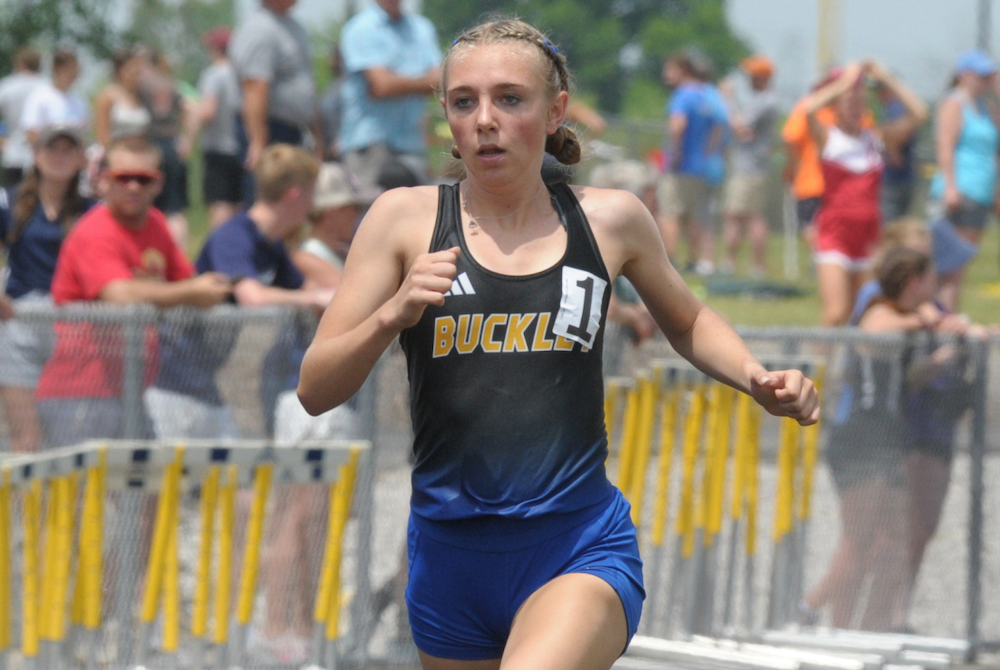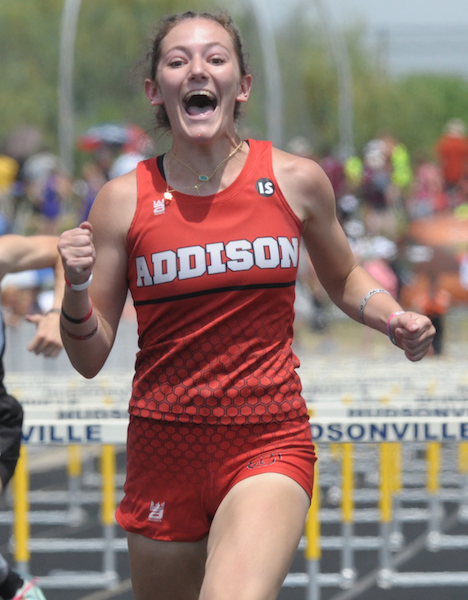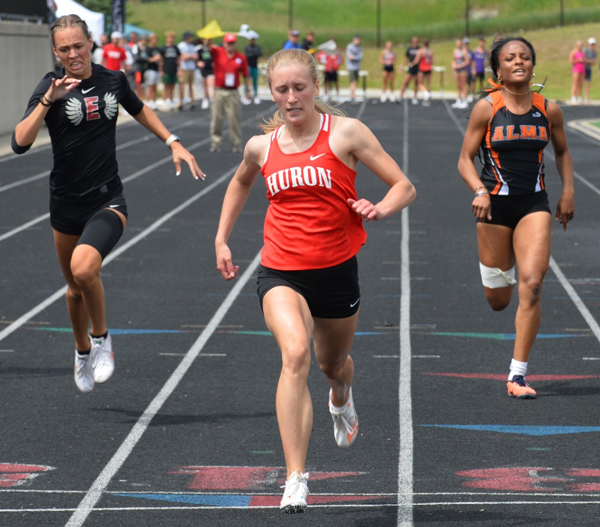
Speedy Sprint-Distance Tandem Carries Buckley to 1st Championship
By
Tom Lang
Special for MHSAA.com
June 3, 2023
HUDSONVILLE – Buckley capitalized on the balance of junior distance star Aiden Harrand and freshman standout sprinter Brooklyn Fraeze to rack up the points needed to win the Lower Peninsula Division 4 track & field championship with 52 points Saturday at Hudsonville.
The team title was Buckley’s first in girls track & field.
Harrand won the 1,600 for the third-consecutive year and added titles in the 800 and the 3,200, leading her team to the championship. Those three wins followed her cross country Finals championship from the fall.
“I think it’s kind of fun,” she said about racking up the titles. “My team motivates me, I mean we’re in it as a group and my points matter, so I do it for them.
 “It was a cool experience to have, winning those two,” she said about the two longest races, the 1,600 and 3,200, which were the hardest of the overall meet due to the low 90s/high 80s heat and searing sun all day. Race officials allowed the unique opportunity for coaches to spray the runners with water and give them water bottles.
“It was a cool experience to have, winning those two,” she said about the two longest races, the 1,600 and 3,200, which were the hardest of the overall meet due to the low 90s/high 80s heat and searing sun all day. Race officials allowed the unique opportunity for coaches to spray the runners with water and give them water bottles.
“The water on the backstretch was so nice, and I’m really glad it was there,” Harrand said about the unusual experience. “My coaches were spraying me, and that was so nice to have.
“And our girls took first overall, so we’re really excited for that. Me and Brooklynn (Fraeze) had lots of points, and our 4 x 400 (eighth place) got us the last points we needed. It was amazing, and this is why we do it.”
Fraeze, a freshman, won 100 dash with a personal best of 12.47. She added a runner-up finish in the 200.
“I was like, oh my gosh I’m doing it, the finish line is right there,” she said about the last 10 meters of the 100, as she finished just ahead of Molly Brown of Addison (12.57).
Brown later won the 100 hurdles.
“The girl who got second place, I felt her at like the halfway point and I was telling myself ‘I’ve got to go,’” Brown said of the hurdles win. “And after I finished the race, I was thinking about it and I heard my family yelling for me. I saw my dad and I started crying; there’s just a lot of emotions.”
Her team finished sixth.
Portland St. Patrick was the team runner-up, just three points back at 49. Indian River Inland Lakes took third, Fowler was fourth and Hillsdale Academy took fifth.
Mount Pleasant Sacred Heart senior Anna Plum successfully defended her 300 hurdles title.
 “I think I was actually seeded third, but I had high expectations since I won last year and I really wanted that again,” Plum said. “It’s kind of like validation.
“I think I was actually seeded third, but I had high expectations since I won last year and I really wanted that again,” Plum said. “It’s kind of like validation.
“We put in great practices, and God, honestly,” she credited as factors for her win and the team’s focus. “We are Sacred Heart and believe in God and put a lot of trust in that.
“My feet are pretty hot right now,” Plum added about the weather conditions. “I bet I’ve got some pretty big blisters. I don’t even know how the 3,200 runners do it. It was insane today.”
Rylee Scheurer led St. Patrick by winning the 200 (25.82), and Natalie Wandrie keyed Inland Lakes’ pursuit with wins in the shot put (39-8) and discus (128-11). Frankfort in the 400 (50.68), Fowler in the 800 (1:47.17) and Hillsdale Academy in the 1,600 (4:08.08) and 3,200 (9:57.73) were relay champions, and Beal City’s Kaylee Locke won the 400 (58.55).
Marlette’s Olivia Findlay won the high jump (5-4) and Wyoming Potter’s House Christian’s Sohanny Gonzalez-Castillo won the long jump (17-4). Deckerville’s Rebecca Moeller was first in the pole vault (10-6).
PHOTOS (Top) Buckley's Aiden Harrand sets the pace in the 1,600 on Saturday. (Middle) Addison's Molly Brown celebrates her win in the 100 hurdles. (Below) Mount Pleasant Sacred Heart's Anna Plum clears a hurdle during the 300. (Photos by Ken Swart/RunMichigan.com.)

Multi-Sprint Champ Racing to Finish Huron Career Ahead of the Rest Again
By
Keith Dunlap
Special for MHSAA.com
May 25, 2023
NEW BOSTON – If there was one thing Elizabeth Anderson took pride in elementary school, it was simply showing that she could outrun everyone in sight.
 In fact, Anderson has an explanation for all the success she had in those playground races.
In fact, Anderson has an explanation for all the success she had in those playground races.
“Dominance when you are in elementary school,” Anderson quipped. “I don’t think I ever had a nickname. I just think everyone knew I was fast.”
Years later, pretty much everyone who follows track & field in the state of Michigan can attest to that.
A senior for New Boston Huron, Anderson has been faster than most other competitors in the state during her three-year high school career (with her freshman season in 2020 canceled due to COVID-19).
Last year, Anderson won titles at the Lower Peninsula Division 2 Finals in the 200-meter (25.07) and 400-meter (56.28) dashes, and was runner-up in the 100-meter dash (12.23).
Often, top sprinters focus on one or two of those three races. But Anderson is certainly a different breed of sprinter because she does all three.
In fact, she holds school records in all three of those events, and if all that weren’t enough, Anderson is a part of all three sprint relay teams.
“It is hard to give her events off,” said New Boston Huron head girls track coach Danielle Lobato.
Despite the different styles the 100, 200 and 400-meter dashes present, Anderson said there usually isn’t much adjusting when she goes from one of those races to another.
 The strategy is simply, “Let’s beat the other girls to the finish line.”
The strategy is simply, “Let’s beat the other girls to the finish line.”
“I don’t really go into each race changing up how I would run,” she said.
While enjoying and succeeding in all three races, Anderson said she actually does have a favorite among them.
“I would say the 400 is probably my favorite,” she said. “Even though it hurts, it’s satisfying to see how much you can get your time down in the 400 compared to any other race.”
Anderson said she started running track in sixth grade, but really got serious about it during the summer after her sophomore season, when she was invited to run for a local club.
Eventually, that led to her competing over the winter in indoor events.
She lived and breathed track so much that last fall, she decided to not run cross country so she could focus on a weightlifting regimen aimed at developing more leg strength.
“Once I started doing summer track, I realized I wanted to be doing this all the time,” she said.
Lobato said oftentimes in practice, Anderson is a de facto coach, given there is no better person she can think of for the younger runners on the team to learn from.
“I can’t always demonstrate these things I’m trying to teach,” she said. “You get to see it in real life (from Anderson), not in a YouTube video.”
After winning the 100, 200 and 400-meter dashes at her Regional meet last week, Anderson has her sights set on achieving the same trifecta of titles at next Saturday’s Finals in Grand Rapids.
Anderson has signed to run track at Michigan State, but has been plenty motivated to keep producing this spring in her final high school season.
“I’m really looking to defend my titles,” she said. “That is what is really motivating me to keep going. I want to keep in shape for the college season. I don’t want to lose any of the progress I have made. Ultimately, I just love running track.”
And since elementary school, Anderson has loved — and succeeded in — outrunning everyone else to the finish line.
“We knew we were getting something special,” Lobato said of when Anderson arrived in high school. “But you never expect this. All that she has accomplished is amazing.”
 Keith Dunlap has served in Detroit-area sports media for more than two decades, including as a sportswriter at the Oakland Press from 2001-16 primarily covering high school sports but also college and professional teams. His bylines also have appeared in USA Today, the Washington Post, the Detroit Free Press, the Houston Chronicle and the Boston Globe. He served as the administrator for the Oakland Activities Association’s website from 2017-2020. Contact him at [email protected] with story ideas for Oakland, Macomb and Wayne counties
Keith Dunlap has served in Detroit-area sports media for more than two decades, including as a sportswriter at the Oakland Press from 2001-16 primarily covering high school sports but also college and professional teams. His bylines also have appeared in USA Today, the Washington Post, the Detroit Free Press, the Houston Chronicle and the Boston Globe. He served as the administrator for the Oakland Activities Association’s website from 2017-2020. Contact him at [email protected] with story ideas for Oakland, Macomb and Wayne counties
PHOTOS (Top) New Boston Huron's Elizabeth Anderson clears the finish line during last season's LPD2 400 race. (Middle) Anderson, middle, outpaces the field to also win the 200. (Click for more from RunMichigan.com.)

